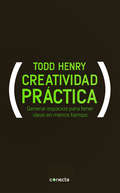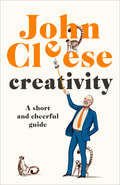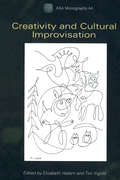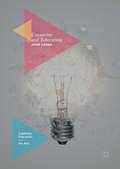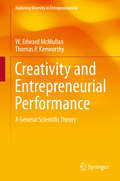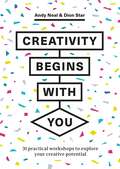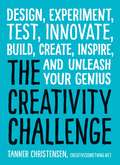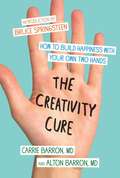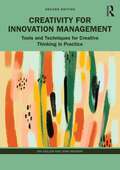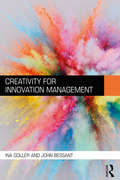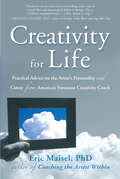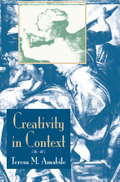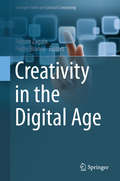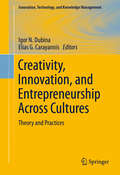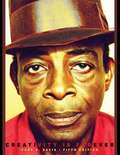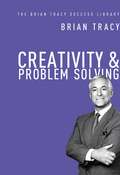- Table View
- List View
Creatividad práctica: Generar espacios para tener ideas en menos tiempo
by Todd HenryCreatividad práctica ofrece un método eficaz para que el lector descubra su propio ritmo creativo en su actividad cotidiana, ya sea diseñador, consultor o simplemente un «creativo accidental». Solemos pensar que los procesos creativos deben reservarse para situaciones extraordinarias, mientras que en el día a día nos vemos empujados por una actividad frenética que deja poco margen para la creatividad. Sin embargo, los niveles de exigencia en nuestro trabajo nos obligan a innovar de forma constante, independientemente del tipo de actividad a la que nos dediquemos, de ahí, la importancia de estimular todo nuestro potencial creativo. En opinión del experto en creatividad empresarial Todd Henry, todo proceso creativo es rítmico; nunca conseguiremos generar mejores ideas de una manera sostenida simplemente trabajando más horas. Resulta imprescindible introducir en nuestra rutina espacios para los procesos creativos, en lugar de esperar a que se filtren entre los resquicios de una agenda de trabajo de locos. Encontrar mejores ideas, trabajar más rápido y sin estrés. Reseñas:«Un libro de incalculable valor para todo aquel que ejerza un trabajo intelectual.»Seth Godin, autor de La vaca púrpura «Este libro generará dos versiones diferentes de su lector: la primera, antes de leerlo y la segunda, después, con una capacidad potenciada al máximo.»Ricardo Crespo, vicepresidente senior y responsable global de creatividad, 20th Century Fox FCP «Creatividad práctica me sorprendió porque resulta práctico y relevante para cualquiera que tenga responsabilidades creativas. Contiene innumerables ejemplos.»Tim Hale, vicepresidente senior de marketing y diseño, Fossil «¡El mito del creativo excéntrico ha muerto! Henry Todd convierte el misterioso proceso de crear en un método brillante y controlado.»Richard Westendorf, director creativo, Landor Associates
Creativity: A Short and Cheerful Guide
by John CleeseThe legendary comedian, actor, and writer of Monty Python, Fawlty Towers, and A Fish Called Wanda fame shares his key ideas about creativity: that it&’s a learnable, improvable skill.&“Many people have written about creativity, but although they were very, very clever, they weren't actually creative. I like to think I'm writing about it from the inside.&”—John Cleese You might think that creativity is some mysterious, rare gift—one that only a few possess. But you&’d be wrong. As John Cleese shows in this short, practical, and often amusing guide, it&’s a skill that anyone can acquire. Drawing on his lifelong experience as a writer, Cleese shares his insights into the nature of the creative process and offers advice on how to get your own inventive juices flowing. What do you need to do to get yourself in the right frame of mind? When do you know that you&’ve come up with an idea that might be worth pursuing? What should you do if you think you&’ve hit a brick wall? We can all be more creative. John Cleese shows us how.
Creativity: A Short and Cheerful Guide
by John Cleese"Many people have written about creativity, but although they were very, very clever, they weren't actually creative. I like to think I'm writing about it from the inside." --John CleeseCreativity is usually regarded as a mysterious, rare gift that only a few possess. John Cleese begs to differ, and in this short, immensely practical, and often very amusing guide he shows it's a skill that anyone can acquire. Drawing on his lifelong experience as a writer, he shares his insights into the nature of the creative process and offers advice on how to get your own inventive juices flowing. What do you need to do to get yourself in the right frame of mind? When do you know that you've come up with something that might be worth pursuing? What do you do if you think you've hit a brick wall? Not only does he explain the way your mind works as you search for inspiration, he also shows that, regardless of the task you've set yourself, you can learn to be better at coming up with a promising idea, refining it, and knowing when you're ready to act on it. We can all be more creative. John Cleese shows us how.
Creativity
by Philippe PetitIn the vein of The Creative Habit and The Artist's Way, a new manifesto on the creative process from a master of the impossible. Since well before his epic 1974 walk between the Twin Towers of the World Trade Center, Philippe Petit had become an artist who answered first and foremost to the demands of his craft--not only on the high wire, but also as a magician, street juggler, visual artist, builder, and writer. A born rebel like many creative people, he was from an early age a voracious learner who taught himself, cultivating the attitudes, resources, and techniques to tackle even seemingly impossible feats. His outlaw sensibility spawned a unique approach to the creative process--an approach he shares, with characteristic enthusiasm, irreverence, and originality in Creativity: The Perfect Crime. Making the reader his accomplice, Petit reveals new and unconventional ways of going about the artistic endeavor, from generating and shaping ideas to practicing and problem-solving to pulling off the "coup" itself--executing a finished work. The strategies and insights he shares will resonate with performers of every stripe (actors, musicians, dancers) and practitioners of the non-performing arts (painters, writers, sculptors), and also with ordinary mortals in search of fresh ways of tackling the challenges and possibilities of everyday existence.
Creativity and Crime
by David H. Cropley Arthur J. CropleyCreativity is typically perceived to be a positive, constructive attribute and yet, highly effective, novel crimes are committed which illustrate that creativity can also be utilized to serve a darker and more destructive end. But how can these 'creative criminals' be stopped? Adopting a psychological approach, renowned subject experts Cropley and Cropley draw upon concepts such as 'Person,' 'Process', 'Press' and 'Product' to explain how existing psychological theories of creativity can be applied to a more subtle subset of ingenuity; that is to say criminal behaviour and its consequences. Creativity and Crime does not look at felony involving impulsive, reflexive or merely deviant behaviour, but rather the novel and resourceful measures employed by criminals to more effectively achieve their lawbreaking goals. The book transcends the link between crime and creativity, and proposes a range of preventative measures for law enforcers. Scholars and graduates alike will find this an invaluable and illuminating read.
Creativity and Cultural Improvisation (Asa Monographs)
by Elizabeth HallamThere is no prepared script for social and cultural life. People work it out as they go along. Creativity and Cultural Improvisation casts fresh, anthropological eyes on the cultural sites of creativity that form part of our social matrix. The book explores the ways creative agency is attributed in the graphic and performing arts and in intellectual property law. It shows how the sources of creativity are embedded in social, political and religious institutions, examines the relationship between creativity and the perception and passage of time, and reviews the creativity and improvisational quality of anthropological scholarship itself. Individual essays examine how the concept of creativity has changed in the history of modern social theory, and question its applicability as a term of cross-cultural analysis. The contributors highlight the collaborative and political dimensions of creativity and thus challenge the idea that creativity arises only from individual talent and expression.
Creativity and Education (Creativity, Education and the Arts)
by Anne HarrisThis book advances an environmental approach to enhancing creativity in schools, by interweaving educational creativity theory with creative industries environmental approaches. Using Anna Craft's last book Creativity and Education Futures as a starting point, the book sets out an up-to-date argument for why education policy should be supporting a birth-to-workplace approach to developing creative skills and capacities that extends across the education lifespan. The book also draws on the voices of school teachers, students and leaders who suggest directions for the next generation of creative teachers and learners in a rapidly evolving global education landscape. Overall, the book argues that secondary schools must find a way to make more room for creative risk, innovation and imagination in order to adequately prepare students for creative workplaces and publics.
Creativity and Entrepreneurial Performance: A General Scientific Theory (Exploring Diversity in Entrepreneurship)
by W. Edward Mcmullan Thomas P. KenworthyThe essential problem in entrepreneurship is improving the performance of entrepreneurs. The most important theories will be the ones that most enable us to predict and then ultimately influence entrepreneurial performance. This book develops a new and more accurate theory of entrepreneurial performance based in entrepreneurial creativity. The field of entrepreneurship has a long tradition of expecting entrepreneurial performance to be influenced by creativity, tracing back even before the pioneering work of Joseph Schumpeter (1883 to 1950), who defined entrepreneurship as creative-destruction--creating the new by supplanting or destroying the old. Subsequently, psychologist Robert Sternberg defined creativity as broadly encompassing creative aspects of personality, motivation, intellect, thinking style and relevant knowledge. Using Sternberg's definition of creativity, the authors reviewed the evidence directly linking entrepreneurial creativity and entrepreneurial performance, concluding that the linkage is both statistically and practically significant. In order to scientifically tie entrepreneurship to creativity the book pursues a number of major objectives: In parts one and two, the authors remind us of our scientific challenge in the light of the depressing levels of performance typically to be found in the real world of entrepreneurship and explores the limitations of the dominant paradigms driving research in the field of entrepreneurship today. In part three, they bring together existing evidence to demonstrate the predictive and explanatory powers of creativity in relation to entrepreneurship. In part four, they further explore correlations between creativity and entrepreneurial performance at the individual and macro or society, levels. In summary, the book offers a bold predictive theory linking entrepreneurial creativity to entrepreneurial performance, however neither as boldly as a definitional linkage nor as timidly as one in a hundred or so factors potentially explaining entrepreneurial performance. This result is a general scientific theory that offers a serious challenge to entrepreneurial scholars who are pursuing other means for understanding the causality of entrepreneurial performance.
Creativity Begins With You: 31 Practical Workshops to Explore Your Creative Potential
by Andy Neal Dion StarCan creativity be 'taught'? Or is it simply innate? This book will help you find your creativity through your own unique identity and experience, challenging you to fight those negative voices, get out of your habitual comfort zones and - most importantly - play. Part practical workshop and part provocative guide, Creativity Begins With You is an invaluable companion for any student working across the creative disciplines.
Creativity Begins With You: 31 Practical Workshops to Explore Your Creative Potential
by Andy Neal Dion StarCan creativity be 'taught'? Or is it simply innate? This book will help you find your creativity through your own unique identity and experience, challenging you to fight those negative voices, get out of your habitual comfort zones and - most importantly - play. Part practical workshop and part provocative guide, Creativity Begins With You is an invaluable companion for any student working across the creative disciplines.
The Creativity Book
by Eric MaiselA complete creativity education in one volume. Everything you need to know to increase and unleash your creativity, by America's leading expert on the psychological side of creativity. Whether you're a painter or a human resources manager, a novelist or an information services specialist, says Eric Maisel, whatever you do, creativity helps you do it better. In this book, Maisel presents a complete one-year plan for unleashing your creativity. It uncludes two discussions/exercises per week, and culminates in a guided project of your choice--from working on your current novel to planning a new home business.
The Creativity Challenge
by Tanner ChristensenDiscover your "Aha" moment--right now!What's the best way to become more creative? Just change how you think! This book challenges you to go against your default ways of thinking in order to write, design, and build something extraordinary. Featuring more than 100 challenges, exercises, and prompts, each page guides you as you push past the way you normally see the world and uncover all-new possibilities and ideas. The Creativity Challenge teaches you that you already have immense creative potential in you--you just need to tap into it.Whether you're feeling stumped or uninspired, these creativity prompts will help you ditch typical thinking patterns and finally unleash the possibilities hidden within your mind.
The Creativity Challenge: Design, Experiment, Test, Innovate, Build, Create, Inspire, and Unleash Your Genius
by Tanner ChristensenAs seen on Inc.com Discover your "Aha" moment--right now!What's the best way to become more creative? Just change how you think! This book challenges you to go against your default ways of thinking in order to write, design, and build something extraordinary. Featuring more than 100 challenges, exercises, and prompts, each page guides you as you push past the way you normally see the world and uncover all-new possibilities and ideas. The Creativity Challenge teaches you that you already have immense creative potential in you--you just need to tap into it.Whether you're feeling stumped or uninspired, these creativity prompts will help you ditch typical thinking patterns and finally unleash the possibilities hidden within your mind.
The Creativity Cure: A Do-It-Yourself Prescription for Happiness
by Carrie Barron Alton BarronA Do-It-Yourself Prescription for HappinessIn their insightful book, wife-and-husband physicians Carrie and Alton Barron present an innovative, highly achievable five-part plan to unleash happiness and alleviate depression and anxiety by tapping into creative potential. A gifted psychiatrist and a premier hand surgeon, Carrie and Alton Barron draw upon the latest psychological research, a combined forty years of medical practice, and personal experience to demonstrate how creative action is integral to long-term happiness and well-being. The Five-Part Prescription for the Creativity Cure--Insight, Movement, Mind Rest, Your Own Two Hands, and Mind Shift--leads the way to a more meaningful, fulfilling life by simultaneously developing self-understanding and self-expression. With the Barrons' detailed tools and strategies for cultivating creative outlets, overcoming unconscious fears and barriers to happiness, and linking internal thought to external action, readers will build the mind-set and habits necessary for happiness and positive change. They will experience--and learn how to sustain--the deep satisfaction that accompanies creating something by hand. The perfect self-help book for our handmade, homemade, crafting culture, The Creativity Cure has a simple yet profoundly inspirational message: that you can find the authentic, contented life you crave by taking happiness into your own two hands.
The Creativity Cure
by Carrie Barron Alton BarronA Do -It-Yourself Prescription Happiness In their insightful book, wife-and-husband physicians Carrie and Alton Barron present an innovative, highly achievable five-part plan to unleash happiness and alleviate depression and anxiety by tapping into creative potential. A gifted psychiatrist and a premier hand surgeon, Carrie and Alton Barron draw upon the latest psychological research, a combined forty years of medical practice, and personal experience to demonstrate how creative action is integral to long-term happiness and well-being. The Five-Part Prescription for the Creativity Cure--Insight, Movement, Mind Rest, Your Own Two Hands, and Mind Shift--leads the way to a more meaningful, fulfilling life by simultaneously developing self-understanding and self-expression. With the Barrons' detailed tools and strategies for cultivating creative outlets, overcoming unconscious fears and barriers to happiness, and linking internal thought to external action, readers will build the mind-set and habits necessary for happiness and positive change. They will experience--and learn how to sustain--the deep satisfaction that accompanies creating something by hand. The perfect self-help book for our handmade, homemade, crafting culture, The Creativity Cure has a simple yet profoundly inspirational message: that you can find the authentic, contented life you crave by taking happiness into your own two hands.
Creativity for Innovation Management: Tools and Techniques for Creative Thinking in Practice
by Ina Goller John BessantCreativity for Innovation Management is a rigorous yet applied guide, which illustrates what creativity is, why it matters, and how it can be developed at both individual and group levels. Unlike many technique-oriented books, this book combines theory with practice, drawing on the latest research in psychology, organisational behaviour, innovation and entrepreneurship. The text provides a range of opportunities to explore innovative and creative processes and develop them via activities linked to relevant tools and techniques, as well as real-life case studies. By working through key competence areas at personal and then team levels, the book demonstrates to students how to build entrepreneurial practices, strong, innovative teams, and organisations that encourage and facilitate innovative thinking. This second edition has been updated throughout, including a new chapter exploring the impact of emerging technologies on creativity, further material on human-centred design, crowdsourcing and collaboration platforms, and cross-cultural differences in innovation management. This textbook is ideal for postgraduate students of Innovation and Creativity and Entrepreneurship, as well as professionals who want to excel by developing and applying their own creativity at work. Online resources complement the book, with access to key tools, techniques, and activities, as well as supporting video and audio material and cases, to support learning and teaching.
Creativity for Innovation Management
by Ina Goller John BessantCreativity for Innovation Management is a rigorous yet applied guide which illustrates what creativity is, why it matters, and how it can be developed at both individual and group levels. Unlike many technique-oriented books, this book will combine theory and practice, drawing on the latest research in psychology, organizational behaviour, innovation and entrepreneurship. This exciting new text outlines the necessary skills and competences for innovative and creative processes. It provides opportunities to explore these and also to develop them via a wide variety of activities linked to relevant tools and techniques, as well as a range of case studies. By working through key competence areas at personal and then team levels, students then have an opportunity to practice and enhance these skills. This will be complemented by online resources which will provide students with access to key tools and techniques plus activities to help develop their creativity. This textbook is ideal for students of innovation, management and entrepreneurship, as well as professionals in those industries that want to excel by developing and applying their own creativity at work.
Creativity for Life: Practical Advice on the Artist's Personality, and Career from America's Foremost Creativity Coach
by Eric Maisel PhDAs a therapist and creativity coach, Eric Maisel has worked with thousands of creative people. He knows firsthand the struggles that writers, musicians, artists, dancers, and actors face and has helped them find balance in their lives while pursuing their artistic endeavors. His new book presents a comprehensive approach to the much-misunderstood life of the artist. Creativity for Life offers practical ideas as well as exercises and inspiration to nurture growth as an artist and as a person, exploring such subjects as: Establishing your creativity practice Obscurity and stardom Blocks The artist’s personality Moods and madness Artists in love Craft The rewards and perils of isolation Social interactions and community
Creativity In Context
by Teresa M AmabileCreativity in Context is an update of The Social Psychology of Creativity, a classic text for researchers, students, and other interested readers. Creativity in Context incorporates extensive new material, going far beyond the original to provide a comprehensive picture of how the motivation for creative behavior, and creativity itself, can be influenced by the social environment. Teresa Amabile describes new findings from both her own research and from the work of many others in the field, detailing not only the ways in which creativity can be killed by social-psychological influences, but also the ways in which it can be maintained and stimulated. The research and the theory have moved beyond a narrow focus on the immediate social environment to a consideration of broad social influences in business organizations, classrooms, and society at large; beyond a documentation of social influences to a consideration of the cognitive mechanisms by which social factors might impact creativity; and beyond subject populations consisting of children and college students to an inclusion of professional artists, research scientists, and other working adults. Amabile describes a greatly expanded set of methodologies for assessing creativity, and introduces a set of methodologies for assessing the social environment for creativity in non-experimental studies. Throughout, the book maintains a clear focus on a comprehensive view of creativity--how the social context can influence motivation and how motivation, in conjunction with personal skills and thinking styles, can lead to the expression of creative behavior within that context. The result is a clarified theory of how creativity actually happens, with strong implications for supporting and increasing essential aspects of human performance.
Creativity in the Digital Age (Springer Series on Cultural Computing)
by Nelson Zagalo Pedro BrancoThis edited book discusses the exciting field of Digital Creativity. Through exploring the current state of the creative industries, the authors show how technologies are reshaping our creative processes and how they are affecting the innovative creation of new products. Readers will discover how creative production processes are dominated by digital data transmission which makes the connection between people, ideas and creative processes easy to achieve within collaborative and co-creative environments. Since we rely on our senses to understand our world, perhaps of more significance is that technologies through 3D printing are returning from the digital to the physical world. Written by an interdisciplinary group of researchers this thought provoking book will appeal to academics and students from a wide range of backgrounds working or interested in the technologies that are shaping our experiences of the future.
Creativity, Innovation, and Entrepreneurship Across Cultures: Theory and Practices (Innovation, Technology, and Knowledge Management)
by Elias G. Carayannis Igor N. DubinaThe aim of this volume is to further develop the relationship between culture and manifold phenomena of creativity, innovation and entrepreneurship in order to promote further and better understanding how, why, and when these phenomena are manifested themselves across different cultures. Currently, cross-cultural research is one of the most dynamically and rapidly growing areas. At the same time, creativity, inventiveness, innovation, and entrepreneurship are championed in the literature as the critical element that is vital not just for companies, but also for the development of societies. A sizable body of research demonstrates that cultural differences may foster or inhibit creative, inventive, innovative and entrepreneurial activities; and each culture has its own strengths and weaknesses in these regards. Better understanding of cultural diversity in these phenomena can help to build on strengths and overcome weaknesses. Cross-cultural studies in this field represent a comparatively new class of interdisciplinary research. This is a field where cultural, sociological, psychological, historical, economic, management, technology and business studies closely intersect. In this book, a global team of researchers representing Europe, Asia, and the Americas review, analyze, structure, systematize and discuss various concepts, assumptions, speculations, theories, and empirical research which focus on the effect of national cultures on creativity, invention, innovation, and entrepreneurship. They argue that national culture is not only an extremely important determinant of innovation and business development, but also demonstrate that some aspects relating to these phenomena may be universal among all cultures, thereby identifying those factors that may easily be transferred across cultures from those that are unique to their specific context.
Creativity Is Forever (5th edition)
by Gary A. DavisThis book was prepared for any adult interested in better understanding the topic of creativity, becoming a more creative person, or teaching others to think more creatively. It is true that much about human creativity remains---and will remain---an intriguing mystery. It is difficult indeed to untangle the drives, thoughts images, and inspirations of a Thomas Edison, Georgia O'Keeffe, or Walt Disney. As we will see in Chapter 3, extraordinarily creative people have not understood their own creativeness. However, it also is absolutely true that we do understand much about creativity and creative people---their energetic and curious personalities, their ideas--finding processes and strategies, and the circumstances that support or squelch their lively imaginations and innovative thinking.
The Creativity Leap: Unleash Curiosity, Improvisation, and Intuition at Work
by Natalie Nixon"Natalie Nixon's new book provides a fresh primer on how to cultivate creativity in the workplace.&” —Nir Eyal, bestselling author of Hooked and IndistractableToo many people associate creativity solely with the arts, even though to be an incredible scientist, engineer, or entrepreneur requires immense creativity. And it's the key to developing breakthrough products and services. Natalie Nixon, a creativity strategist with a background in cultural anthropology, fashion, and service design, says that in the fourth industrial revolution a creativity leap is needed to bridge the gap that exists between the churn of work and the highly sought-after prize called innovation.Nixon says that since humans are hardwired to be creative, it is a competency anyone can develop. She shows that it balances wonder (awe, audacity, and curiosity) with rigor (discipline, skill-building, and attention to detail), and that inquiry, improvisation, and intuitionare the key practices that increase those capacities. Drawing on interviews with fifty-six people from diverse backgrounds—farming, law, plumbing, architecture, perfumery, medicine, education, technology, and more—she offers illuminating examples of how creativity manifests in every kind of work. Combining creativity tools and techniques with real-world stories of innovative people and businesses, this book is a provocation, an inspiration, and an invitation to unleash the innate creativity that lies within each of us. It offers a more dynamic and integrative way to adapt and innovate, one that allows us the freedom to access our full human selves.
Creativity & Problem Solving: The Brian Tracy Success Library (Brian Tracy Success Library)
by Brian TracyThe crucial element separating an exceptional career from a lackluster one is the ability to devise innovative solutions to work challenges. With research showing the direct relationship between ideas and profitability, creative thinking skills are vital to professional advancement. As one of the world's premiere success experts, Brian Tracy knows that creativity can be developed with practice and a few helpful tools. This concise book reveals 21 proven, practical techniques readers can use to immediately begin generating a stream of productive ideas, including how to: Stimulate the three primary triggers to creativity * Inspire a creative mindset in staff through recognition, rewards, and environment * Use methods such as Brainstorming, Zero-Based Thinking, Nominal Group Technique, and Lateral Thinking to solve problems, improve systems, devise new products, and come up with fresh, exciting marketing angles * Ask focused questions to generate elegant solutions * Understand the difference between mechanical and adaptive thinking * Rigorously evaluate new ideas . . .without shutting down the creative impulse Containing mind-stimulating exercises and down-to-earth strategies, this career-changing book helps anyone tap into the root source of their own intuitive genius.
Creativity Rules: Get Ideas Out of Your Head and into the World
by Tina SeeligInternational bestselling author and Stanford University professor Tina Seelig adapts her wildly popular creativity course to a practical guide on how to put your best ideas into action.For the past fifteen years, Professor Tina Seelig has taught her Stanford students how to creatively unleash their unique entrepreneurial spirits. In Creativity Rules, she shares this wisdom, offering inspiration and guidance to transform ideas into reality. Readers will learn how to work through the four steps of The Invention Cycle: Imagination (envisioning things that do not yet exist), Creativity (applying your imagination to address a challenge), Innovation (applying creativity to generate unique solutions), and Entrepreneurship (applying innovation, to bring ideas to fruition, where our ideas then gain the power to inspire the imaginations of others). Using each step to build upon the last, you can create something much complex, interesting, and powerful.Creativity Rules provides the essential knowledge to take a compelling idea and transform it into something extraordinary.
